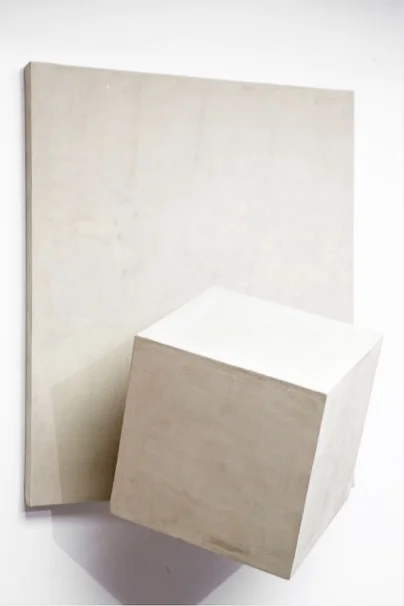Luisi Llosa
Luisi Llosa, advocates to the body as the place where all the wounds of our society caused by violence, inequality and war, come to take form. Understanding the body as an abstract place, fragile and prone to be violated, as a place that in its surface carries and showcases all the wounds that we seem to bring upon each other.
Studied Visual Arts at Escuela Superior de Arte Corriente Alterna. She has participated in workshops in Chile, Argentina and Lima, and has carried out a residency in Australia. Her works have been presented in various group exhibitions in Lima, Washington and Sydney, among other cities. Her work is based on the idea of the most basic sensations of everyday life and the daily confrontation of human beings with the contradictions and ruptures that come from the simple "being in the world". Currently, she lives and works in Lima.
Luisi Llosa's work is a mental reconfiguration that she develops on her person. Composed of bricks, pieces covered with microcement, daily objects detained in time and operated, screwed blocks and torn and perforated monoliths, all the pieces as a whole comprise the ruins of their past.
Looking at them as isolated objects makes no sense. It would be pretending to know everything about a person from a single action of this. Each work dialogues with the next and the previous one and the one in front, thus establishing a system (I dare say "closed") endowed with a specific -hostile- language: paralysis.
Each of Llosa's works is then made up of a series of stopped, damaged and even abandoned steps. Among them the viewer can perceive small calls. I am cannon fodder, the play shouts. The pain materializes, it becomes another; indifference makes use of language; the violence of the above is the form of what is present here. As if Llosa, lent a code to those who look at the work, a system of symbols where anyone who wants can deposit their pain, regrets and frustrations.
It is the feeling of being in a foreign land, where one, at times, believes that they understand everything, but then understands little again. Llosa's works are a deposit, a room of her psyche that the Peruvian artist has managed to tear apart from her interior. But they force you to look at your own past, where it comes from. "The artist is the trunk of the tree that takes vitality from the ground, from the depths (the unconscious)", writes Herbert Read appropriating the words of Paul Klee, adding: "to transmit it to the top of the tree, which is beauty ”(Herbert Read, Style and expression).
In short, the entire work is not Llosa, but the mirror of what once was, and the remnants of what will never cease to be. What we are all about. It is, as I said at the beginning, the painful reconfiguration of all this.
Here I leave the residues of my pain As if they were cinerarias, Luisi Llosa's jars keep the pain. The tears that lie in the seven containers Here I leave the residues of my pain are a mechanism of catharsis and memory. In a gesture that materializes violence, suffering, and restlessness, the artist takes artistic language as a means of self-healing and liberation. "Here, in this supreme danger," wrote Nietzsche in The Birth of Tragedy - "approach him, art, as a magician who saves and heals: only he is capable of twisting those nauseous thoughts about the dreadful or absurd of the existence… ”.
The material accumulation of pain, expressed in crying, manifests itself as ashes of the body: pieces torn off, violated and reduced forever, and whose natural place of permanence is the memory that appears as a living condition of the present. From that horizon, over the course of seven years, Llosa has charted a path with the aim of externalizing psychic discomfort. She presents us here with an exercise for independence, but not as a total liberation, but rather as a way to lighten the burden of suffering through the fragile work of art, the sublime, understood in The Birth of Tragedy, as "artistic submission of the dreadful”.
Here I leave the residue of my pain is a work that emerges from the bowels, a work built from necessity. In this sense, the artist's crying is not limited to the artistic field, but also constitutes a testimony of mistreatment, abuse, and psychological violence. The tears, collected annually in each of the flasks exhibited, establish a single body of pain whose cause and beginning in time are unique and whose extension is uncertain. The containers, being positioned in a horizontal line, refer to the repetition and permanence of suffering. Each year does not establish an overcoming of pain, on the contrary, it reaffirms it.
However, the absolute gesture resides in the support of the work. The rusty steel plate alludes to the weight of time and the brutality of traumatic memory. On the other hand, the curves engraved on the base reproduce the Forgetting Curve, developed based on the Hermann Ebbinghaus memory studies. Llosa falsifies these curves with the only possibility, implicitly exhibited, that these sobbing-filled jars can multiply in time just by accessing that past sculpted in abuse. It is inevitable to think of the jars as if they were cinerary. In the same way that we preserve the cremated remains of our loved ones in those vessels, Luisi Llosa preserves her own remains, the multiple deaths of her self-love. Because nobody wants to keep very close to that or to those who have left, but neither do we allow ourselves to make them disappear forever; because nobody wants to carry pain all their lives, but neither can we conceive our identity outside of those tears that, like a chisel, have shaped our most private face in detail.
BIO
Luisi Llosa (Perú, 1981)
She studied Visual Arts at the Escuela Superior de Arte Corriente Alterna. She then traveled to Sydney where she was invited for a year to do a residency and begin to figure out what her topic of interest really was. Her works have been presented in various group and solo exhibitions in Lima, Washington, Madrid, Chile, Bogotá, Argentina and Sydney, among other cities. Her works are in various private collections of Peruvian and foreign collectors. Her work is based on the idea of showing the most basic and primary sensations of daily life and the daily confrontation of us, as human beings with humanity, showing the contradictions and ruptures that come from inhabiting this world.






























